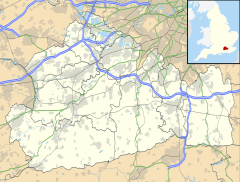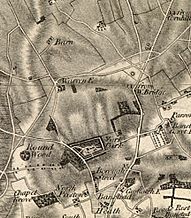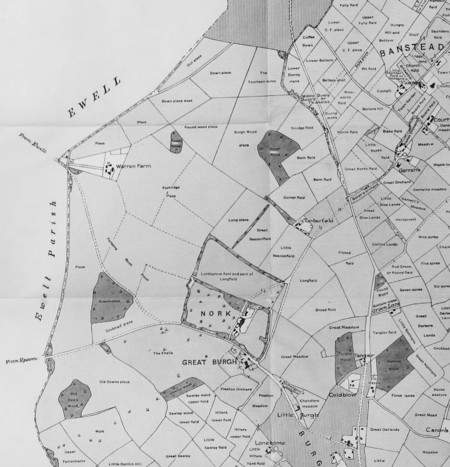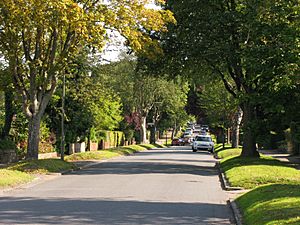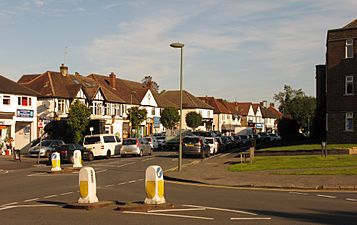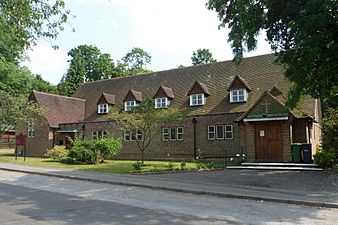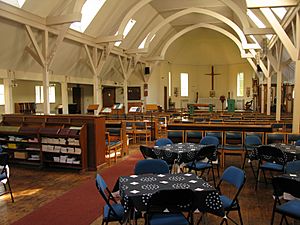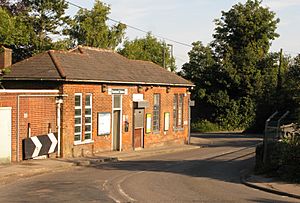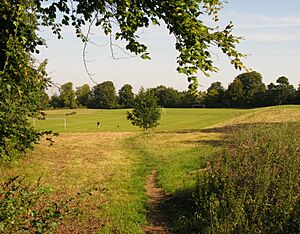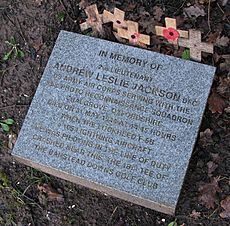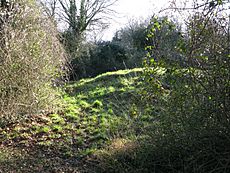Nork, Surrey facts for kids
Quick facts for kids Nork |
|
|---|---|
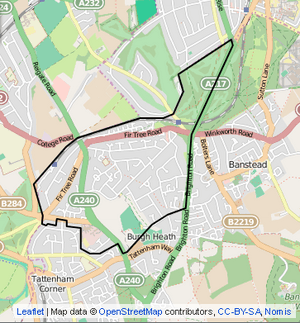 Nork ward in 2011, outlined in black |
|
| Area | 3.63 km2 (1.40 sq mi) |
| Population | 7,559 (2011 Census) |
| • Density | 2,082/km2 (5,390/sq mi) |
| OS grid reference | TQ241598 |
| District |
|
| Shire county | |
| Region | |
| Country | England |
| Sovereign state | United Kingdom |
| Post town | Banstead |
| Postcode district | SM7 |
| Post town | Epsom |
| Postcode district | KT17 |
| Dialling code | 01737 |
| Police | Surrey |
| Fire | Surrey |
| Ambulance | South East Coast |
| EU Parliament | South East England |
| UK Parliament |
|
Nork is a residential area in Surrey, England. It's part of the borough of Reigate and Banstead and is very close to Greater London. Nork is separated from its nearby town, Banstead, by a main road called the A217. It also connects to other areas like Tattenham Corner and Burgh Heath.
Nork sits on chalk hills, near the top of the North Downs. Its highest point is about 175 meters (575 feet) above sea level. You'll find two main areas with shops here. One is called the Driftbridge, and the other is at the end of Nork Way, a central street in the area.
Contents
Exploring Nork's Past
The name "Nork" might come from a few different ideas. Some think it's from a Latin word, noverca, which means "stepmother" but was used for a feature that overlooked a fort. Others believe it comes from an old English word, "nook," meaning a quiet corner. A third idea is that it means "northern oak."
The name "Nork" was first written down in 1723 for a field called "Nork close." Later, in 1740, Nork House was built by Christopher Buckle. His family owned the nearby Burgh Manor for many years. In the 1700s and 1800s, Nork was mostly a farming area, like a small hamlet of Banstead village. It included the fields and buildings around Nork Park. A line of trees planted to mark the park's edge gave its name to Fir Tree Road.
In 1834, a famous robbery happened on what is now Yew Tree Bottom road. A man named Mr. Richardson was returning from a market when he was attacked. Later, in 1865, a railway line was built, mainly to serve the Epsom Racecourse.
In 1880, a large home for children opened in Nork, between Fir Tree Road and the railway. It was first called "The Kensington and Chelsea District School" and later "Beechholme". At its busiest, over 400 children lived there. The school closed in 1974, and new homes were built in its place.
In the 19th century, the Buckle family sold their land to the Perceval/Arden family. They then sold it to the Colman family, famous for their mustard. In 1923, the Nork estate was sold to a company that wanted to build houses. Nork House itself was taken down in 1939.
Many new houses were built after 1923. In 1925, the Nork Residents' Association was started. They still publish a regular newsletter today. Nork officially became a place name in 1965 when Banstead was divided into two areas, "Banstead Village" and "Nork."
During World War II, Nork was sometimes hit by bombs and crashing planes. Soldiers were stationed in Nork Park, living in old estate buildings and special huts called Nissen huts. After the war, these huts were used as temporary homes before being taken down. Building new homes continued after the war.
Interesting Places and Buildings
In a front garden on The Drive, you can find Tumble Beacon. This is an ancient monument, a scheduled ancient monument. It was originally a prehistoric burial mound, called a bowl barrow, built on one of the highest points in the area. Later, in Tudor times, it was built up to be a beacon. A fire would be lit there to warn people if enemies were coming. During World War II, an air-raid shelter was dug inside it.
A group of Saxon burial mounds, or hlaews, are in the northern part of Nork. When one was dug up in 1972, archaeologists found items from the late 600s or early 700s. These included a spear, a knife, a shield boss, and fabric. The main burial was of a tall warrior, about 1.9 meters (6 feet) tall, who rode horses often. He was likely in his late 20s. Five other skeletons found there seemed to be from centuries later, possibly victims of the medieval gallows that gave the area its name, Gally Hills.
In 1912, the Colman family rebuilt a large house called Great Burgh. This neo-Georgian house is now a Grade II listed building, meaning it's protected for its history. It was used for scientific research by different companies, including British Petroleum and Beecham Pharmaceuticals. Later, Toyota used it for offices. Since 2016, it's been used by the Science Group. The house's architect, Ernest Newton, also designed its beautiful gardens.
Some other "locally listed buildings" include two old cottages, Driftways and Crossways, built around 1890. West Lodge, a stone gatehouse for Nork House, is also locally listed. Two 19th-century stone gate pillars at the end of Ruden Way also came from an entrance to the Nork Park estate. The old Drift Bridge Hotel is locally listed partly because the wood used to build it in 1931 came from HMS Ganges, the Royal Navy's last sailing flagship.
What Nork Offers
Most of the homes in Nork are detached or semi-detached houses. They were built at different times, so they have many styles. Many of these homes have very large gardens. The streets often have grassy areas with trees between the road and the sidewalk.
The shops at the end of Nork Way have small convenience stores and local services. These include newsagents (with a post office), restaurants, car repair shops, a bakery, and a pharmacy.
In the western part of Nork, there's another small group of shops called The Driftbridge. It's named after the old Drift Bridge Hotel and garage nearby. The hotel later became a restaurant and then apartments in 2007. Nork doesn't have any hotels or pubs anymore.
The Anglican church of St Paul in Warren Road opened in 1930 to serve the new homes in Nork. The Roman Catholic and Methodist churches for Banstead are also located in the Nork area.
These three churches each have a hall for events. Other places for local events and indoor sports include the community center in Nork Park and Scout Ridge near Banstead Station.
Getting Around Nork
Banstead railway station is near the shops at the north end of Nork Way. It's on a single-track line that goes between Epsom Downs station (also in Nork) and Sutton, where trains continue to London. When the line opened in 1865, Epsom Downs station had 9 platforms for racecourse visitors! But in 1989, the station was rebuilt with just one platform. Tattenham Corner station is also a short walk from parts of Nork.
Nork also has several bus routes. Some go right through Nork, while others can be reached from nearby streets. You can take buses to places like Epsom, Croydon, Sutton, Mitcham, Redhill, Gatwick Airport, and Crawley.
Schools in Nork
Warren Mead Infant School and Warren Mead Junior School are both in Nork. The Beacon School is a secondary school located next to Nork Park. It used to be called Nork Park School. Many students from Nork also go to schools further away.
Nork Park: A Great Place to Play
Nork Park is south of the main residential area, next to Tattenham Corner and Burgh Heath. It used to be part of the large park around Nork House. The local council bought it in 1947.
Today, the entire park is open to everyone. It has areas of chalk grassland with interesting plants, as well as hedges, tree-lined paths, and woodlands. It's a popular spot for dog walking. The park also has large playing fields, tennis and basketball courts, an exercise trail, and two playgrounds for children. There's also a community center.
Every summer, the local community holds a popular outdoor music festival called "Music in the Park." In 2022, they celebrated their 30th event!
Banstead Downs: Nature and History
About one-third of Banstead Downs is in the northern part of Nork, where there's a golf course. Banstead Downs is a special area for nature, called a Site of Special Scientific Interest. The golf course has different types of grassland with many chalk-loving plants, including some rare ones. It also has areas with mixed bushes that are important for birds. Over 57 types of birds have been seen here, and 44 of them have nested. There are also older oak and hawthorn trees. The area is home to some very rare insects.
Banstead Downs has been protected thanks to a 16-year legal fight in the late 1800s. People wanted to save the land from being used for houses. Because of this, since 1893, the Downs has been managed by the Banstead Commons Conservators.
Near the 18th hole of the golf course, there's a memorial to an American pilot, Lt. Andrew Jackson. He bravely steered his plane away from houses when it crashed here in 1944. Also on this golf course is the Gally Hills ancient monument, which we talked about earlier.
The London Loop, a long walking trail around London, passes through Nork here. It crosses the Brighton Road (A217) just north of Banstead Crossroads. The walk is divided into sections that start and end near public transport, and Banstead Station is one of these official access points.
Who Lives in Nork?
The 2011 census counted 7,556 people living in Nork. About 22% were under 18, and 19% were over 65. Nork is generally a well-off, middle-class area. Many adults (38%) have university degrees or professional qualifications. Most adults (79%) have jobs. In 2011, only 6% of homes didn't have a car, and 60% had more than one. Most residents (92%) were white, and 90% were born in the UK.
Famous People from Nork
- Admiral Matthew Buckle (1718–1784)
- George James Perceval, 6th Earl of Egmont (1794–1874), an admiral and Member of Parliament.
- Frederick Edward Colman (1841–1900), who was in charge of Colman's mustard company. He bought Nork House in 1890 and lived there until he died. His family stayed until 1923.
- The author and radio producer Simon Brett (born 1945) grew up in Nork.
- The comedian David Walliams (born 1971) grew up in Nork and used to work as a lifeguard at Banstead Sports Centre.


